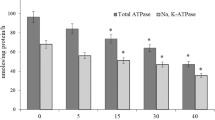Abstract
Cadmium compounds are found widely in our environment: for example, in food, water, soil, and ambient air. The most important exposure route of animals to cadmium in the general environment is via oral exposure. In oral cadmium intoxication, the immediate target organ is the gastrointestinal tract. The aim of the present work was to determine how cadmium acts on the intestinal absorption of sugars and on the sucrase activity through rabbit jejunum, after in vitro administration and/or oral administration of CdCl2 in drinking water. Results obtained show that cadmium decreasesD-galactose accumulation in the jejunum tissue. This effect seems to be the result of an action mainly located on Na+-dependent sugar transport of the mucosal border of the intestinal epithelium, because cadmium seemnnot to modify the sugar diffusion across the intestinal epithelium. Cadmium has also been shown to inhibit the (Na+-K+)-ATPase activity of the enterocyte, which might explain the inhibition of theD-galactose Na+-dependent transport. Nevertheless, a direct action of the cadmium molecule on the Na+-dependent carrier cannot be discarded. Cadmium altered the sucrose activity when it was administered in the drinking water for 4 d.
Similar content being viewed by others
References
O. F. Andersen, J. B. Nielsen, and P. Svendsen,Toxicology 48, 225–236 (1988).
O. Andersen, J. B. Nielsen, and P. Svendsen,Toxicology 52, 65–79 (1988).
C. E. Bevan and E. C. Foulkes,Toxicology 54, 297–309 (1989).
L. Friberg, M. Piscator, G. F. Nordberg, and T. Kjellström,Cadmium in the Environment, 2nd ed., C.R.C. Press, Cleveland, OH (1974).
S. Jamall, M. Naik, J. J. Sprowls, and L. D. Trombetta,Toxicol. Appl. Pharmacol. 9(5), 339–345 (1989).
G. O'Brien and L. J. King,Toxicology 56, 87–94 (1989).
C.-G. Elinder, inCadmium and Health. A Toxicological and Epidemiological Appraisal, vol. 1, L. Friberg, C.-G. Elinder, T. Kjellström, and G. F. Nordberg, eds., CRC, Boca Raton, FL, 1985, pp. 47–51.
W. Tsuchiya and Y. Okada,Experientia 38(9), 1073 (1982).
K. V. Sastry and K. M. Subhadra,Water Air Soil Pollut. 20, 293–297 (1983).
D. S. Miller, A. T. Shehata, and J. Lerner,J. Pharmacol. Exp. Therap. 214(1), 101–105 (1980).
D. S. Miller,J. Pharmacol. Exp. Therap. 216(1) 70–76 (1981).
A. Klip, S. Grinstein, J. Biber, and G. Semenza,Biochim. Biophys. Acta 598 (1), 100–114 (1980).
S. Kojima, M. Kiyozumi, T. Honda, T. Shimizu, Y. Moriyama, and E. SueyoshiChem. Pharm. Bull. 34(1), 372–377 (1986).
V. Lyall, R. Nath, and A. Mahmood,Biochem. Med. 22, 192–197 (1979).
M. J. Rodríguez-Yoldi, A. Lugea, A. Barber, M. LLuch, and F. Ponz,Rev. Esp. Fisiol. 45 (suppl), 207–214 (1989).
D. W. Watkins, C. Chenu, and P. Ripoche,Pflügers Arch. Eur. J. Physiol. 415, 165–171 (1989).
M.-C. Rodríguez-Yoldi, J. E. Mesonero, and M.-J. Rodríguez-Yoldi,Pflügers Arch. Eur. J. Physiol. 418(6), R-171 (1991).
E. Brot-Laroche, M. A. Serrano, B. Delhomme, and F. Alvarado,J. Biol. Chem. 261 (14), 6168–6176 (1986).
A. Dahlqvist,Anal. Biochem. 7, 18–25 (1964).
J. R. Del Castillo and J. W. L. Robinson,Biochim. Biophys. Acta 688, 45–56 (1982).
F. Proverbio and J. R. Del Castillo,Biochim. Biophys. Acta 646, 99–108 (1981).
M. Bradford,Anal. Biochem. 72, 248–254 (1976).
R. G. D. Steel and J. H. Torrie,Principles and Procedures of Statistics. A Biometrial Approach. McGraw-Hill Book Company, Inc., New York (1980).
F. Alvarado and R. K. Crane,Biochem. Biophys Acta 56, 170–172 (1962).
J. R. Del Castillo and G. Whittembury,Biochim. Biophys. Acta 910, 209–216 (1987).
C. Bevan, E. Kinne-Saffran, E. C. Foulkes, and R. K. H. Kinne,Toxicol. Appl. Pharmacol. 101, 461–469 (1989).
K. R. Kim, H. Y. Lee, C. K. Kim, and Y. S. Park,Toxicol. Appl. Pharmacol. 106, 102–111 (1990).
E. Brot-Laroche and F. Alvarado, inIntestinal Transport, M. Gilles-Baillien and R. Gilles, eds., Springer-Verlag, Berlin, Heidelberg, 1983, pp. 147–169.
Author information
Authors and Affiliations
Rights and permissions
About this article
Cite this article
Mesonero, J.E., Yoldi, MC.R. & Yoldi, MJ.R. Effect of cadmium on enzymatic digestion and sugar transport in the small intestine of rabbit. Biol Trace Elem Res 38, 217–226 (1993). https://doi.org/10.1007/BF02785306
Received:
Accepted:
Issue Date:
DOI: https://doi.org/10.1007/BF02785306




